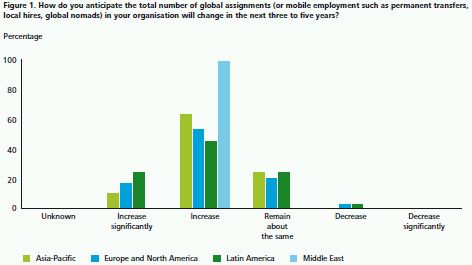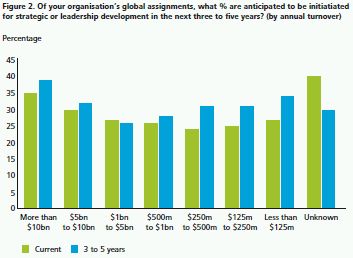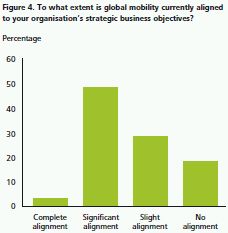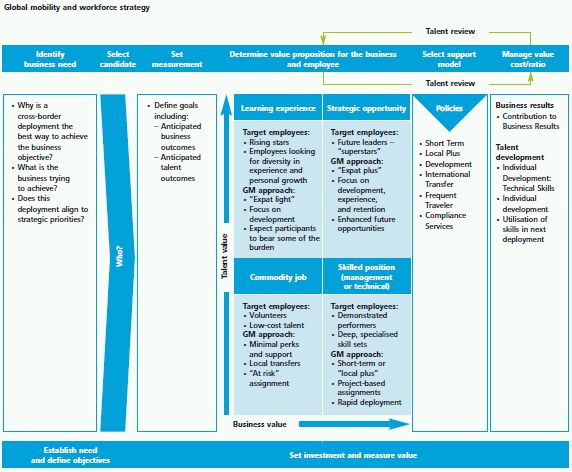FOREWORD
Companies need to be both strategic and nimble in order to survive and prosper in an increasingly competitive New World, buffeted by fluctuating fortunes in mature markets and rapid but inconsistent growth in emerging markets. The war for talent remains a key barrier to growth and organisations need to plan to develop their top talent giving them relevant global experience, but at the same time they need to be able to move quickly to get the right people, in the right place, when opportunities arise. Companies that adopt a strategic approach to global mobility are more likely to take advantage of the opportunities for growth because their expertise and leadership is focused in the right geographies, products and sectors.
In this, our first Strategic Moves survey, we have asked companies to rate their approach to global mobility and to comment on the importance of mobility to their strategic business and talent objectives. We have also sought to explore whether their mobility function is aligned to their business and which critical issues it should address.
Deloitte surveyed over 140 organisations across the globe from a broad array of industries in order to understand the challenges they faced in managing global mobility. Participants represented major regions, evenly balanced across Asia-Pacific, Europe, North America and South America, as well as an even split between responses from HR and those from business lines. More than a quarter of companies that took part have an annual turnover of over $10bn, with an aggregate of at least 30,000 global assignments.
Following collation of the survey results, initial themes were developed and these findings were validated with input from major multinational organisations through in-depth discussions. This process enabled us to verify themes and to develop the background arguments in more detail. We have also used our experience working with multinational organisations to inform the commentary.
In the report we have set out the findings from the survey and interviews in more detail, illustrating the strategic priorities, the talent issues and the effectiveness of global mobility. Within these we have sought to address some of the challenges, complexities and responses which we would expect companies to encounter.
EXECUTIVE SUMMARY
At a high level the survey makes it clear that the global mobility of human capital will become increasingly important over the next three to five years due to the complexity of doing business on a global scale and the increasing importance of emerging markets. HR leaders and senior business executives agree that, more than ever, global mobility needs to become further integrated into core HR processes and act as a strategic partner to the business – complementing the company's strategic business objectives and its talent agenda.
Three key themes common across all survey participants emerged:
- The importance of a global mobility strategy
The findings show that global mobility is an increasingly important strategic enabler which should align to core business objectives. Three quarters of participating companies anticipate that the total number of globally mobile employees will increase or increase significantly over the next three to five years and over 80% of organisations anticipate that global mobility will become more important or significantly important over the same period.
The overwhelming majority of respondents (88%) feel it is important or critically important to align their organisation's global mobility strategy with their business strategy, with nearly half of all organisations surveyed agreeing that their top strategic business issue is emerging geographical markets. These figures are complemented by the Deloitte CFO Survey: 2011 Q3 Results which highlight that growth continues to dominate the agenda of CFOs around the world, with the majority sighting overseas expansion as a key business priority. In reality however, there is a significant disconnect with only 2% of participants believing that mobility is currently aligned to these objectives.
The increasing importance of global mobility programmes emphasises the need to establish a formal global mobility strategy. Moving global mobility to this next level will require careful planning, focused investments, and the development of new advanced capabilities. Global mobility is a significant investment – one that can easily top $25-30million per 100 assignees. At these costs, businesses need to know that they are focusing their efforts on critical priorities and getting a return on their investment. - The need to integrate mobility and talent
Developing new leaders and providing them with experience to grow new markets is crucial, however the current lack of integration with talent programmes and strategies means that many organisations will not be able to fill their talent pipelines with the global leaders required for future growth. The survey results show that 60% of respondents feel global mobility is important or critically important to meeting their talent agenda. A further 37% feel that it is becoming more important. This illustrates that there is a growing recognition that getting the right people in the right place at the right time is important to the business both in immediate terms, and in relation to talent development. Global leadership and pipeline was selected by a third of respondents as the global mobility issue most critical to their organisations' successes. However, surprisingly only 11% feel this issue is fully supported by their current mobility programme.
Supporting organisational business needs means supporting the overall talent and mobility agenda of the organisation. This requires understanding the broad business and talent objectives and assisting in the integration of international experience in global competency development so they can have the right people, in the right jobs, in the right locations. - Enhancing the value of global mobility
The survey findings reflect our understanding of the challenges facing chief executives and HR leaders. Global mobility functions have grown reactively, with responsibilities often split by Talent, Operations, HR Shared Service Centres and disparate pockets of mobility expertise with no overall strategic direction or realisation that global mobility can enable many of an organisation's business objectives. Approximately 40% of survey participants believe their global mobility programme needs significant or radical improvement. A further 36% feel that their programme is adequate, with room for improvement. In total therefore, three quarters of the organisations that participated in this survey rated their mobility function as no better than adequate.
Greater significance can be placed on the fact that nearly half of the business executives (outside HR) consider their mobility to be underperforming and not fulfilling the business and talent requirements compared to only 33% of HR respondents. This is the clearest indication that there is a significant disconnect between the perception of those within HR and those within the business in terms of whether global mobility is fit for purpose.
Closing the gap
The transition from global mobility being viewed as a transactional cost centre to a value-add strategic partner is a difficult one. Less than 10% of participants feel that their organisation currently perceives global mobility as a fully strategic function. The findings reflect our understanding of the challenges facing chief executives and HR leaders. The development of strategic expertise within global mobility functions will be an important way for companies to address the challenges ahead. This will enable companies to ensure that their mobility strategy aligns with their business and talent objectives, and will also enable global mobility to deliver a more cost-effective and targeted service.
Global mobility alignment
In our view, world-class mobility programmes should focus on all three of these themes simultaneously (and flex with talent and business needs) to realign mobility with their organisation's wider business and talent objectives:

|
Key findings from the survey
|
CHAPTER 1: THE STRATEGIC PRIORITIES
Importance of mobility
Our research confirms that global mobility is a strategic business priority. Three quarters of participating companies anticipate that the total number of globally mobile employees will increase or increase significantly over the next three to five years. Alongside the increase in basic volumes comes an escalation in the importance of mobility to the organisation. Nearly 80% of organisations anticipate that global mobility will become more important or significantly more important over the same period.

The increasing importance of the mobility function is a reflection of the role that assignments, transfers and moves have in helping companies meet their strategic objectives. This includes permanent transfers, local hires and global nomads, as well as more traditional long and short-term assignees. The results also highlight that the greatest expectation and reliance of mobile talent comes from the largest multinationals, with turnover of more than $10bn.
There is also an increasingly strategic focus on the moves themselves. Business pressures such as rapid growth in the emerging markets, globalisation and competition have forced companies to re-assess their use of mobility as a tool simply for stop-gap resourcing towards a more thought-out approach. The immediate role that top talent are taking in developing new business is reflected in the fact that companies anticipate changes in the proportion of moves that are strategic in nature. We asked companies to estimate the proportion of their global assignments falling in to four categories: Experience, employee initiated, knowledge transfer or strategic talent/leadership development. Our results indicate that the majority of companies currently use global mobility as a means to support a resource gap or transfer knowledge and this trend will decrease over the next 3-5 years.
At the same time however, our results also indicate that around 26% of current moves are initiated specifically for strategic talent or leadership development but there is also an expectation that this will increase over the next three to five years. This highlights that multinationals already recognise the importance of strategic global deployment, even if they have not yet implemented new models.

Within the responses there is a secondary alignment to turnover. Larger multinationals are more strategic in their use of mobile employees and assignments than smaller companies. Those with turnover of more than $10bn have the highest proportion of strategic moves. Moreover, there is a broad correlation between turnover and proportion of strategic moves, with reducing turnover equating to a reducing strategic focus. From this we can see that the most successful companies are those that prioritise strategic deployment of resources.
From a global mobility standpoint this is a significant finding, however it is important to recognise that knowledge transfer, basic resourcing and movement of expertise between markets will always be a key component of mobility, despite the fact that companies are focused on the top talent at present. In fact, these kinds of moves still represent the largest proportion of mobile employees now and in the next 3-5 years as previously stated. Organisations operating in highly specialised technical areas are increasingly reliant on mobile expertise. This is more cost-effective than employing technical specialists in all geographies, and also allows consistent ways of working and culture to be embedded across the organisation.

Recognition of the importance of knowledge transfer and expertise also ensures that companies have a holistic approach to mobility. The top talent and the development assignments may be of a higher profile and make use of international workforce planning, global employment companies or similar structures but it is also possible to approach knowledge transfer and expertise in a more strategic manner. Some global companies are moving to a model of international workforce planning for all assignment types, matching requirements to experience on a global basis.
Alignment of mobility to the business
We asked respondents how important it is to align their global mobility strategy with the organisation's business objectives and the overwhelming majority (88%) felt it was important or critically important to do so.
Conversely, there is a huge disconnect as only 2% of business and HR executives reported that global mobility is currently completely aligned to their organisation's strategic business objectives.

There is also a noticeable split based on the background of the respondents, with those from a non HR background twice as likely as those from HR to feel that there is no alignment at all. This points to a gap between HR and the business when it comes to the question of aligning global mobility to the business objectives.
Emerging geographies
Faced with a list of seven alternative issues, nearly 50% of all organisations surveyed agreed that their top strategic business issue is 'emerging geographical markets'. Maximising the opportunity in emerging markets can only be done with the right talent, expertise and ways of doing business. International deployment of resources is a key concern for multinational organisations and the rise of emerging economies and new markets has led to a change in the way organisations need to manage their resources globally.
Many organisations have not had time to develop local talent in these markets so they need to be able to move people from mature markets at the same time as building up their talent locally. This presents a challenge because it can be difficult to facilitate movement, especially in the face of no guarantees of a right to return in the home country. The difficulties arise in identifying, incentivising and moving the right people without spiralling additional cost.

Behind emerging geographies, 'globalisation' and 'competition' were also stated as top strategic business issues. In order to thrive in the increasingly competitive global marketplace businesses need to ensure that future leaders have experience outside their home market and develop a global mindset. This means that as well as moving today's top talent in to emerging markets to drive new business, companies are trying to provide tomorrow's leaders with the right global experience, wherever they might come from.
The nearest alternative issue was advances in technology which only gathered ten percent. This overwhelming result has reinforced our understanding that movement of people, skills, knowledge and culture to emerging markets is driving a more strategic approach to global mobility.
Deloitte's point of view: The importance of a global mobility strategyThe increasing importance of the global mobility function within organisations reinforces the need to establish a clear global mobility strategy. If managed well, it can create far more value for a business. In our experience, effective global mobility requires a formal strategy that focuses on a company's long term business needs and global talent priorities rather than simply reacting to individual opportunities as they arise. Although many organisations spend substantial sums on international assignments, these investments are often made on an ad-hoc basis to fill short-term needs rather than with a view to the enterprise's strategic business and talent priorities. A global mobility and workforce strategy that establishes objectives and guidelines for the company's global mobility efforts can help leaders make informed decisions about how to focus their investments and reap the desired returns, both in the short and the long-term. In our view, an effective global mobility and workforce strategy should:
An effective global mobility and workforce strategy fosters a portfolio view of the cost and impact of mobility on the business, and offers a clear business rationale for specific mobility investments. In addition, it provides the basis for a principles-based framework that can help business leaders make smart decisions that align with the organisation's larger business and talent needs. For example, a company might use its global mobility and workforce strategy to develop a decision guide to help business leaders determine which positions are best filled through the global mobility programme, and which employees are best suited for particular assignments. Furthermore, an understanding of the core business drivers will ensure that the policy and processes are tailored appropriately. For instance, if expansion in the emerging markets is a core business strategy, global mobility can facilitate the movement of talent. The global mobility policy may be designed to include additional compensation or allowances to motivate assignees to go on assignment to these geographies, or in high growth countries remain with the organisation. Likewise, a central budget/alternative cost-sharing approach may be used to encourage host locations to utilise international assignees (rather than pick up the inflated expatriate costs themselves). |
To read this Survey in full, please click here.
The content of this article is intended to provide a general guide to the subject matter. Specialist advice should be sought about your specific circumstances.

